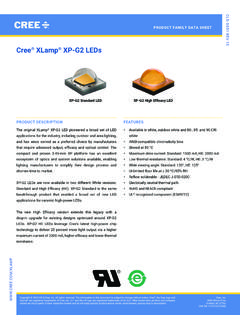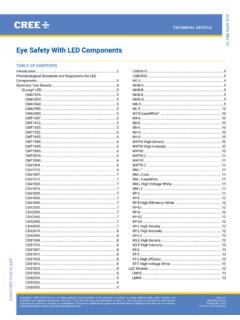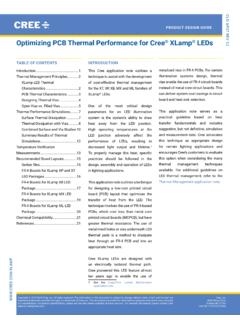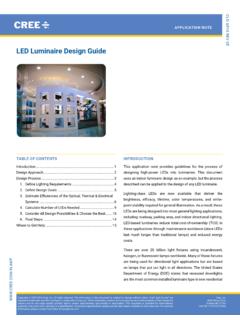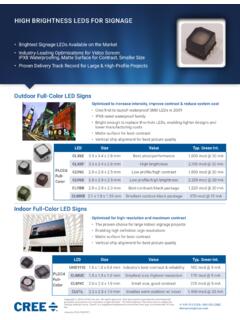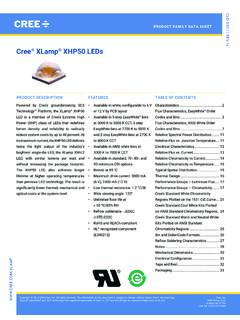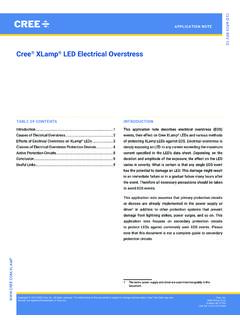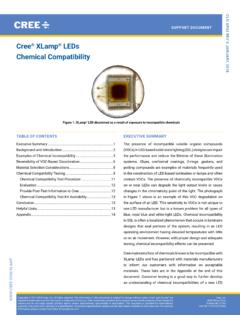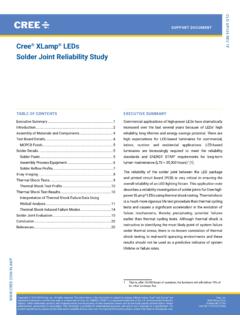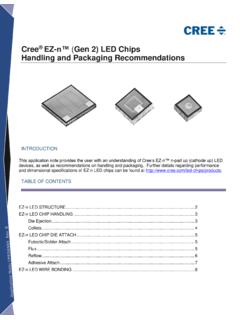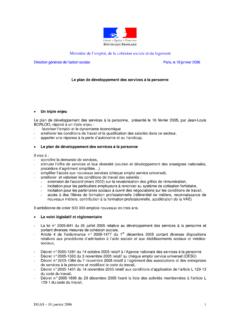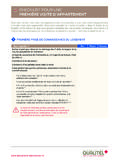Transcription of LED Color Mixing: Basics and Background - Cree Inc.
1 CLD-AP38 REV 1D. Technical Article LED Color mixing : Basics and Background Table of Contents Introduction This application note explains aspects of the theory and practice The Need for Color Consistency in LED of creating Color -consistent, LED-based illumination products LED and shows how to use Cree XLamp LEDs to achieve this end. Colorimetry and Binning LEDs, as with all manufactured products, have material and Color -Space process variations that yield products with corresponding Idealized Illumination Colors the Black Body variation in performance.
2 LEDs are binned and packaged to MacAdam Ellipses: The Variability of Perception, Expressed balance the nature of the manufacturing process with the in Color needs of the lighting industry. Lighting-class LEDs are driven Partitioning the Color Space by application requirements and industry standards, including Chromaticity Color consistency and Color and lumen maintenance. Just as Flux traditional lamps are sold by brightness (typically indicated by Using Colorimetry and Binning Information in Illumination wattage) and Color (warm or cool white), LEDs are binned for brightness (luminous flux) and Color parameters (chromaticity).
3 Additive Nature of Photometry and The Basic Three Use Cree EasyWhite Color mixing in the LED Photometric Copyright 2010-2016 Cree, Inc. All rights reserved. The information in this document is subject to change without notice. Cree , XLamp and Cree, Inc. EasyWhite are registered trademarks and the Cree logo is a trademark of Cree, Inc. ENERGY STAR is a registered trademark of the Environmental 4600 Silicon Drive Protection Agency. This document is provided for informational purposes only and is not a warranty or a specification.
4 For product specifications, Durham, NC 27703. please see the data sheets available at For warranty information, please contact Cree Sales at USA Tel: + LED Color mixing The Need for Color Consistency in LED Illumination Figure 1: The Need for Color Consistency Spans all Illumination There is nothing like a picture to illustrate a visual point such as Color variation. The photograph in Figure 1 clearly shows the need for Technologies every illumination technology to deliver consistent Color . This photograph is an example of the challenges Cree, in conjunction with the lighting industry, is trying to meet for LED lighting applications.
5 Figure 1: The need for Color consistency spans all illumination technologies Figure 1 is a photograph of an array of high-intensity discharge (HID) lamps illuminating the facade of a building. It shows the undesirable results of inconsistent Color temperature and the degradation of performance of luminaires as they age. Increasingly active industrial policy in the United States and throughout the world is resulting in a rigorous set of performance requirements for LED lighting applications. The first industrial policy that mandated illumination technology for LED lamp requirements was the 2007 document, ENERGY STAR Program Requirements for Solid State Lighting Luminaires.
6 This was followed by requirements for LED lamps, enumerated in the 2010 document ENERGY STAR Program Requirements for Integral LED Lamps , which proposed stringent requirements, significantly above those for compact fluorescent lamp (CFL).1 Each of these documents contains requirements for correlated Color temperature (CCT), Color rendering index (CRI), lumen and Color maintenance for an ENERGY-STAR-approved LED. illumination product and have been subsequently revised2,3. CCT requirements are excerpted in Tables 1 and 2 below.
7 1 See 2 3 Copyright 2010-2016 Cree, Inc. All rights reserved. The information in this document is subject to change without notice. Cree , XLamp and EasyWhite are registered trademarks and the Cree logo is a trademark of Cree, Inc. ENERGY STAR is a registered trademark of the Environmental Protection Agency. This document is provided for informational purposes only and is not a warranty or a specification. For product specifications, please see the data sheets available at For warranty information, please contact Cree Sales at 2.
8 LED Color mixing Table 1: ENERGY STAR requirements for integral LED lamps, per program requirements ( ). Reference Standard/Test Sample Size/. Characteristic Requirement Method Specific Requirements Lamp must have one of the following designated CCTs (per IES LM-79-08 10 units per model ANSI ) consistent with the 7-step chromaticity 5 base-up quadrangles and Duv tolerances below. ANSI/NEMA/ 5 base-down ANSLG At least 9 of the 10 samples must Nominal CCT Target CCT (K) and Target Duv and meet the specification CCT and Duv Tolerance Tolerance 2700 K 2725 145 3000 K 3045 175 3500 K 3465 245 4000 K 3985 275 Table 2: ENERGY STAR CCT requirements for indoor LED luminaires, per program requirements ( ).
9 Characteristic Requirements CCT requirements: all indoor The luminaire (directional luminaires), or replaceable LED light engine or GU24 based integrated LED lamp (non-directional luminaires luminaires) shall have one of the following nominal CCTs: 2700 Kelvin 3000 Kelvin 3500 Kelvin 4000 Kelvin 5000 Kelvin (commercial only). The luminaire, LED light engine or GU24 based integrated LED lamp shall also fall within the corresponding 7-step chromaticity quadrangles as defined in ANSI/NEMA/ANSLG These requirements highlight the need to achieve defined, repeatable results with the manufacturing output from an LED supplier.
10 LED Binning LEDs can be characterized in multiple ways. For Color mixing , the two most important dimensions are Color expressed as chromaticity (CCx, CCy), and luminous flux, measured in lumens (lm). These parameters are collected as part of the LED component manufacturing process and are the basis for the component binning discussed in this document. Colorimetry and Binning Basics It is easier to explain the world of LED colorimetric binning and mixing by reviewing a bit of high-level Color science.
